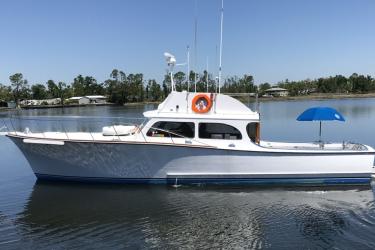Key Message:
The Direct Enhancement of Snapper Conservation and the Economy through Novel Devices Act of 2020 (DESCEND Act) requires persons on commercial, for-hire, and private recreational vessels to have a venting tool or descending device rigged and ready to use when fishing for reef fish species in Gulf of Mexico federal waters. The effective date of the DESCEND Act is January 13, 2022. NOAA Fisheries has a final rule clarifying the definitions of a descending device and venting tool that will publish January 14, 2022.
When the DESCEND Act will take effect:
- The DESCEND Act is effective January 13, 2022.
When the Rule will take effect:
- The rule will publish on January 14, 2021 and clarifying regulations from that rule will be effective February 14, 2022.
Summary of Requirements:
- The DESCEND Act:
- Requires fishermen to have a venting tool or descending device rigged and ready to use when fishing for reef fish by January 13, 2022.
- Applies to fishing for reef fish from commercial vessels, charter vessels and headboats, and private recreational fishing vessels.
- Allows fishermen to choose which device to have rigged and ready for use.
- Does not prevent fishermen from carrying both types of devices as a fisherman may find that they favor certain devices for individual situations.
- The descending device and venting tool requirements expire on January 13, 2026.
- Descending Device:
- An instrument capable of releasing a fish at the depth from which the fish was caught.
- It must be rigged and ready for use when fishing.
- It is a weighted hook, lip clamp, or box that will hold the fish while it is lowered to depth.
- The rule sets a minimum of a 16-ounce weight and a minimum length of 60 feet of line attached to the descending device.
- Venting tool:
- Must be capable of penetrating the abdomen of a fish to release the excess gases accumulated in the body cavity when a fish is retrieved from depth.
- Must be a sharpened, hollow instrument that allows air to escape, such as a hypodermic syringe with the plunger removed.
- The rule sets as a minimum a 16–gauge needle, which has an outside diameter of 0.065 inches, as the minimum diameter hollow tube that must be used.
- Gulf of Mexico reef fish fishermen may also choose to use a larger diameter hollow needle because it will allow air to escape from a fish faster.
- A tool that is not hollow, such as a knife or an ice pick, does not meet the requirements of a venting tool, and must not be used to vent a fish.
Frequently Asked Questions (FAQs)
Why are these fishing gear requirements being implemented?
- Commercial and recreational fishermen have expressed concern about regulations that result in released fish that do not survive.
- Some released fish die due to foul hooking (hooking the fish in the stomach or throat), injuries caused by barotrauma (injury due to expansion of gas when reeled up from depth), handling damage, stress from the fishing process, and predation.
- To improve the survivorship of released fish, Congress developed the Direct Enhancement of Snapper Conservation and the Economy through Novel Devices Act of 2020 (DESCEND Act) that was signed into law on January 13, 2021, by President Trump.
- The purpose of the DESCEND Act is to promote the survival of released reef fish suffering from barotrauma.
- The purpose of this rule is to clarify the definitions of a descending device and venting tool. For example, adding a minimum weight and length of line to the descending device definition.
What does the DESCEND Act do?
- Adds a new section 321 to the Magnuson-Stevens Fishery Conservation and Management Act, requiring persons on commercial, for-hire, and private recreational vessels to have a venting tool or descending device rigged and ready to use when fishing for reef fish species in Gulf of Mexico federal waters.
- Requires fishermen to have a venting tool or descending device rigged and ready to use when fishing for reef fish.
- Applies when fishing for reef fish from commercial vessels, charter vessels and headboats, and private recreational fishing vessels.
- Allows fishermen to choose which device to have rigged and ready for use.
- Does not prevent fishermen from carrying both types of devices as a fisherman may find that they favor certain devices for individual situations.
How is descending device defined in the rule? What constitutes an allowable descending device?
- A descending device is an instrument capable of releasing a fish at the depth from which the fish was caught.
- It must be rigged and ready for use when fishing.
- This means the descending device must be ready to be deployed as soon as reef fish fishing activities begin.
- Most commercially available descending devices have instructions on how to deploy the devices.
- It is a weighted hook, lip clamp, or box that will hold the fish while it is lowered to depth.
- The rule sets a minimum of a 16-ounce weight and a minimum length of 60 feet of line attached to the descending device.
How is venting tool defined in the rule? What constitutes a venting tool?
- A venting tool must be capable of penetrating the abdomen of a fish to release the excess gases accumulated in the body cavity when a fish is retrieved from depth.
- A venting tool must be a sharpened, hollow instrument that allows air to escape, such as a hypodermic syringe with the plunger removed.
- The rule sets as a minimum a 16–gauge needle, which has an outside diameter of 0.065 inches, as the minimum diameter hollow tube that must be used.
- Gulf of Mexico reef fish fishermen may also choose to use a larger diameter hollow needle because it will allow air to escape from a fish faster.
- A tool that is not hollow, such as a knife or an ice pick, does not meet the requirements of a venting tool, and must not be used to vent a fish.
Does the DESCEND Act of 2020 have an expiration date?
- The descending device and venting tool requirements expire on January 13, 2026.
What is barotrauma?
- Barotrauma in fish is an injury caused by the expansion of gas inside a fish from the rapid pressure decrease that occurs when fish are retrieved from the bottom.
- Barotrauma generally occurs when retrieving fish from depths of 90 feet or greater, but it can occur in waters as shallow as approximately 33 feet deep.
- Barotrauma results from internal gases that fill the abdomen and the fish may be unable to swim back down to the capture depth.
- Signs of barotrauma in fish include a distended abdomen, bulging eyes, an everted stomach, and bubbling under the scales.
- Fish experiencing barotrauma often have difficulty swimming to deeper waters or float on the surface, which makes them vulnerable to predation from dolphins, sharks and other fish, and seabirds.
When and how should descending devices or venting tools be used?
- Fishermen can help reduce mortality to fish they release by using a descending device or a venting tool when barotrauma is affecting a fish.
- It is the intent of the DESCEND Act that descending devices or venting tools only be used when a fish may be experiencing barotrauma (e.g., caught in deep water, protruding stomach, etc.).
- Fishermen can use a descending device to lower the fish back to depth where gases recompress and the fish can be released.
- Fishermen can use a venting tool to release gases in the abdomen at the surface allowing fish to swim unaided back to depth after they are released.
- Although the DESCEND Act would allow fishermen to choose whether to carry a descending device or venting tool on a vessel, there is nothing that would prevent fishermen from carrying both types of devices. Fishermen may find that they favor certain devices for individual situations.
Where can I find more information on descending devices and venting tools?
There are a variety of articles and videos readily available online discussing descending devices and venting tools:
- NOAA Fisheries has a webpage on catch and release best practices at https://www.fisheries.noaa.gov/national/resources-fishing/catch-and-release-best-practices
- Florida Sea Grant has a web page titled “Catch and Release Fishing” at https://www.flseagrant.org/fisheries/catch-and-release-fishing
- The South Atlantic Fishery Management Council developed a best fishing practices tutorial, available at https://safmc.net/best-fishing-practices/
- The Return ‘Em Right program is a resource for anglers interested in best release practices at https://returnemright.org/
Where can I find more information on the on the final rule and on the DESCEND Act?
- Contact NOAA Fisheries, Southeast Regional Office
By Mail: Peter Hood
NOAA Fisheries, Southeast Regional Office
Sustainable Fisheries Division
263 13th Avenue South
St. Petersburg, Florida 33701-5505
By FAX: (727) 824-5308
By Phone: (727) 824-5305
- The DESCEND Act may be found online at the NOAA Fisheries Southeast Regional Office Web site at: https://www.fisheries.noaa.gov/action/descending-device-and-venting-tool-direct-enhancement-snapper-conservation-and-economy.
Sign Up For Text Message Alerts - Find Out About Immediate Openings And Closures
NOAA's Text Message Alert Program allows you to receive important fishery related alerts via text message (SMS). Standard message & data rates may apply. You may opt-out at any time.
Text alerts you may receive include:
- Immediate fishery openings and closures
- Any significant changes to fishing regulations that happen quickly
Sign up for one or more of the following groups:
- Gulf of Mexico Recreational Fisheries Related Alerts
- Text GULFRECFISH to 888777
- Gulf of Mexico Commercial Fisheries Related Alerts
- Text GULFCOMMFISH to 888777
- South Atlantic Recreational Fisheries Related Alerts
- Text SATLRECFISH to 888777
- South Atlantic Commercial Fisheries Related Alerts
- Text SATLCOMMFISH to 888777
- Caribbean Fisheries Related Alerts
- Text CARIBFISH to 888777
 Join us every other Friday on NOAA Fish Instagram for Rec Fish Friday!
Join us every other Friday on NOAA Fish Instagram for Rec Fish Friday!
Other contacts:
Media: Kim Amendola, 727-551-5707
Allison Garrett, 727-551-5750


